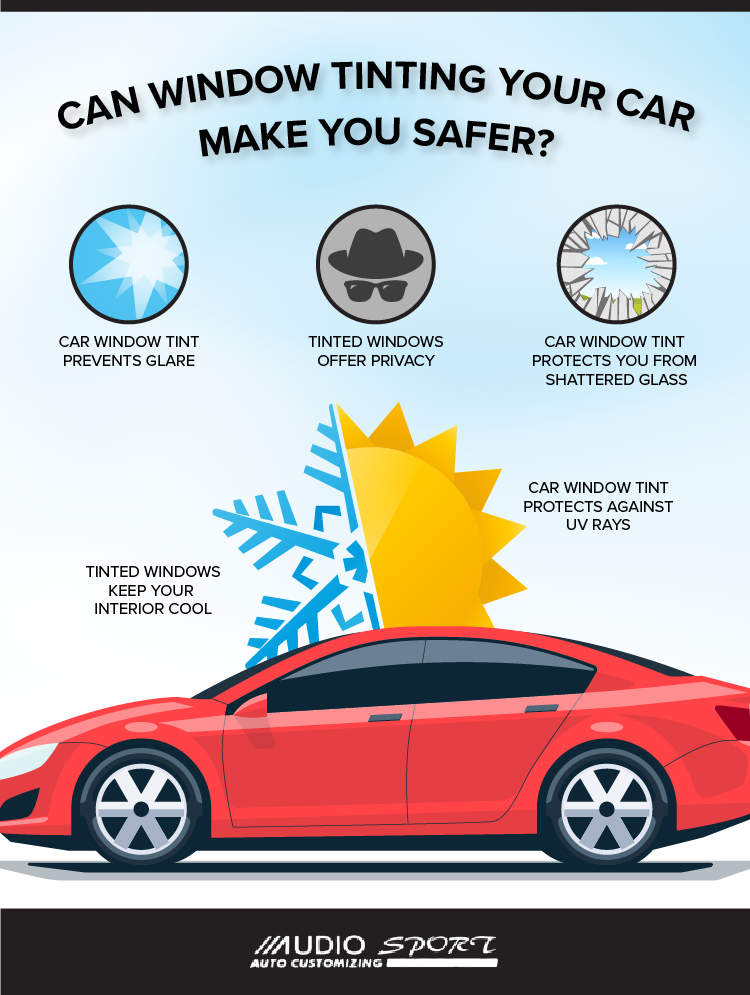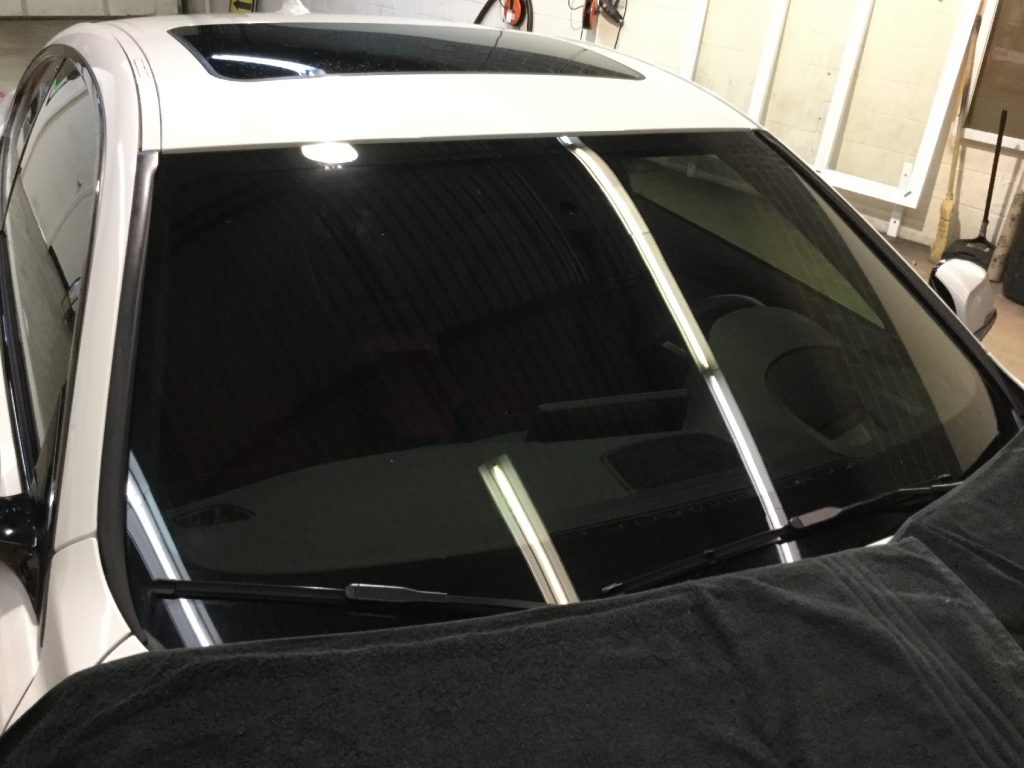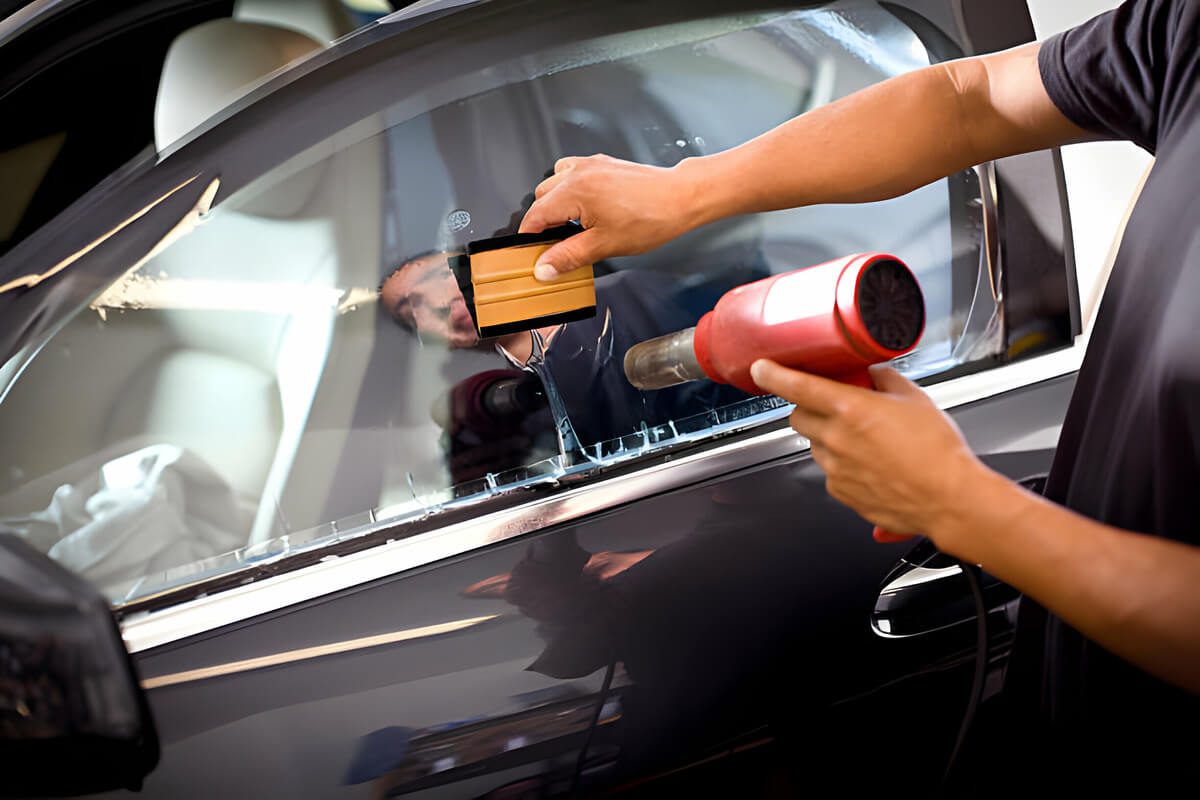A Comprehensive Guide to Comprehending Vehicle Home Window Tint and Its Advantages
Automobile home window tinting serves greater than just a visual function for automobiles. It provides different types, each with unique functions and benefits. Understanding these options, together with lawful laws and upkeep ideas, is crucial for any type of car owner. The advantages may significantly improve driving convenience and automobile longevity. As one explores the nuances of window tinting, the inquiry develops: what kind of color is finest suited for individual demands?
Understanding Car Window Tint: What It Is and Just how It Functions
Car home window color acts as a safety barrier that improves lorry visual appeals while supplying practical benefits. This slim film is used to the interior surface of automobile windows, lowering glare and obstructing dangerous ultraviolet (UV) rays from the sun. By filtering sunshine, car home window tint aids to manage the indoor temperature level of the vehicle, resulting in enhanced convenience for passengers and lowered reliance on air conditioning.Additionally, it shields the car's inside from fading, preserving both upholstery and control panel materials. The color can additionally improve personal privacy, making it a lot more difficult for outsiders to see inside the car. Moreover, specific sorts of home window tint can enhance safety and security; in case of an accident, the movie aids hold destroyed glass together, reducing the risk of injury from flying fragments. Generally, auto home window color offers both visual and functional functions, making it a preferred selection among lorry owners.
Sorts Of Window Color: A Summary of Options
When thinking about home window color choices, a number of kinds are readily available, each with unique attributes. Colored, metalized, and ceramic home window tints provide differing degrees of warm being rejected, UV defense, and visual allure. Recognizing these distinctions can aid car owners make informed selections based upon their preferences and requirements.
Dyed Home Window Color
Dyed window tint represents a popular selection among automobile proprietors seeking a budget-friendly and efficient means to enhance their automobile's aesthetic appeals and privacy. This kind of tint is created by positioning a layer of dye between an adhesive layer and a protective finishing, causing a dark look that decreases glow and enhances visual convenience. While dyed home window color successfully blocks damaging UV rays, it may not offer the same degree of warm rejection as various other tint kinds. Furthermore, its color can fade over time, possibly lessening its efficiency. In spite of these downsides, dyed window color stays popular for its cost-effectiveness and ability to give a smooth, stylish want to different lorry designs.
Metalized Home Window Color
Metalized home window tint supplies a balance of style and performance, making it a popular option among auto owners. This kind of tint includes metal bits within the movie, boosting both aesthetic allure and warmth rejection. The reflective quality of metalized tint helps to reduce glow and enhance personal privacy, while also offering UV security, which safeguards the automobile's inside. Additionally, metalized home window tint can strengthen window stamina, potentially protecting against smashing during mishaps. It is vital to keep in mind that the metal components can interfere with digital signals, such as GPS and cell phone function. On the whole, metalized window tint supplies an effective remedy for those looking for a mix of sturdiness, appearance, and sun protection for their lorries.
Ceramic Window Color
Ceramic home window color represents an innovative choice in the spectrum of automotive home window films, offering distinct advantages over typical colors. Unlike colored or metalized movies, ceramic colors use innovative ceramic bits, which successfully turn down heat and UV rays without compromising visibility. This technology guarantees that cars stay cooler, decreasing reliance on air conditioning and improving fuel performance. In addition, ceramic home window colors are much less most likely to hinder electronic tools, such as GPS or mobile signals, making them a sensible selection for contemporary vehicles. Their longevity and scratch resistance contribute to a much longer lifespan compared to various other kinds of colors. Generally, ceramic window color gives exceptional efficiency, convenience, and security, making it a preferred alternative for critical lorry owners.
Benefits of Auto Home Window Color: Beyond Aesthetics
While lots of people associate automobile home window tint with boosted style, its benefits prolong far past plain visual appeals. One considerable advantage is warmth decrease; home window color can obstruct up to 99% of harmful UV rays, keeping the interior cooler and safeguarding furniture from fading. This not only boosts convenience throughout warm climate yet likewise decreases dependence on air conditioning, bring about improved fuel efficiency.In enhancement, car window color offers an included layer of privacy and protection. Colored home windows make it hard for outsiders to see inside More Info the lorry, which can deter burglary and protect belongings. In addition, numerous tints reinforce the glass, minimizing the likelihood of ruining in the occasion of a crash, thereby improving safety.In enhancement to these useful advantages, car window color can likewise contribute to glow reduction, improving visibility for drivers and passengers alike. This complex strategy to comfort and safety makes home window color a useful investment for car proprietors.
Lawful Considerations: Tinting Rules by State
Before dedicating to auto home window tint, lorry owners have to navigate an intricate landscape of tinting guidelines that differ by state. Each state has specific legislations regulating the permitted levels of color darkness and reflectivity for different windows, including windscreens, front side windows, and rear home windows. These policies commonly include visible light transmission (VLT) percents, which dictate just how much light can go through the tinted glass.Some states allow darker tints on rear home windows while restricting front side and windscreen tints for safety and security reasons. Furthermore, particular states may call for a certificate from the manufacturer to verify compliance with tinting legislations. Violating these guidelines can cause penalties, compulsory removal of the color, or both. It is vital for vehicle proprietors to research their state's legislations completely to assure lawful compliance before installing window tint. This diligence can conserve time and money over time.
Selecting the Right Color: Variables to Take into consideration
When selecting the appropriate window tint for an automobile, numerous vital elements enter play. Tint darkness levels, UV protection ratings, and compliance with legal laws are essential factors to consider to assure both visual appeals and performance - Car Glass Tinting. Examining these elements will help people make an enlightened choice that fulfills their demands and complies with regional regulations
Color Darkness Degrees
Picking the suitable color darkness degree is vital for accomplishing the desired equilibrium in between visual appeals and functionality in auto home window tinting. Different states have varying lawful guidelines concerning tint darkness, which can influence the option. Typically, colors are measured in portions, with lower percents suggesting darker tones. Darker tints supply increased personal privacy and a that site smooth look however can decrease exposure, especially in the evening. Conversely, lighter colors maintain an even more open feeling, making sure adequate presence while still offering some warmth and glare reduction. People need to consider their driving behaviors, neighborhood laws, and individual choices when making a choice. Ultimately, the appropriate tint darkness degree improves the lorry's look while ensuring safety and conformity with lawful criteria.
UV Protection Ranking
Tint darkness degrees play a significant role in the general effectiveness of automobile home window tinting, but one more crucial element to assess is the UV protection score of the picked tint. This score shows the percentage of damaging ultraviolet rays that the tint can block. Top notch colors typically give 99% or more UV protection, safeguarding guests and the car's interior from sun damage. Prolonged exposure to UV rays can result in skin troubles and fading of upholstery, making a high UV defense score important for health and wellness and long life. When picking home window color, consumers must prioritize this ranking along with darkness degrees to guarantee maximum convenience and safety and security while driving. Recognizing these factors help in making an informed decision when buying vehicle home window tinting.
Legal Rules Compliance
Recognizing neighborhood lawful guidelines is vital for anybody taking into consideration automobile home window tinting. Each state or region has particular legislations governing the permitted degrees of tint darkness and reflectivity for different home windows. These policies typically specify the noticeable light transmission percentage, figuring out just how much light can travel through the tinted glass. Non-compliance can lead to fines, necessary removal of the color, or problems throughout lorry evaluations. Furthermore, some locations might have restrictions on using particular tinting materials, content requiring customers to choose items that satisfy security criteria. Consequently, it is essential for vehicle owners to investigate their regional regulations completely before selecting window tint to ensure compliance and prevent potential legal difficulties.
Installment Process: do it yourself vs. Expert Providers
Exactly how does one determine between a DIY setup and hiring expert solutions for auto window tinting? The selection often rests on budget plan, experience, and wanted results. A DIY method can be economical, enabling individuals to reduce labor prices. It calls for a specific degree of ability and knowledge about the tinting process. Those who are meticulous and person might find success with do it yourself sets available in the market.Conversely, specialist solutions provide proficiency and top notch products, ensuring a perfect finish. Professionals commonly assure their job, providing satisfaction versus possible issues such as bubbling or peeling. Additionally, they are familiar with regional regulations pertaining to tinting, which can be intricate for the ordinary car owner.Ultimately, the choice mirrors an equilibrium between expense, individual capability, and the anticipated high quality of the tinting job. Each choice has its benefits, and the finest option depends on individual situations and preferences.
Upkeep Tips: Maintaining Your Tint in Top Problem
Keeping the look and performance of window color needs regular focus and care, especially in differing climate condition. To preserve the color, it is important to avoid utilizing abrasive cleansing materials, which can scratch or harm the film. Car Glass Tinting. Instead, soft microfiber towels and mild, ammonia-free cleaners ought to be used for cleansing the colored surfaces.Furthermore, it is advisable to wait at least 1 month after setup prior to cleaning up the windows to permit the color to totally adhere. Auto parking in shaded areas or utilizing sunshades can assist reduce the fading results of UV rays and prolong the color's lifespan. Routine examinations for bubbles, peeling, or staining are recommended, as early discovery can facilitate repair services. Preventing extreme temperature variations, such as pushing warm windows in chilly climate, will certainly help preserve the tint's integrity and look over time.
Often Asked Concerns

Exactly How Long Does Home Window Tint Typically Last on a Lorry?
Home window tint commonly lasts in between five to 10 years, depending upon factors such as quality, application, and environmental conditions. Normal maintenance and correct care can expand its life expectancy, guaranteeing excellent performance and look in time.
Can Home Window Tinting Damages My Vehicle's Original Glass?
Window tinting, when used appropriately, does not harm a cars and truck's initial glass. Nevertheless, incorrect installment or low-grade products may lead to concerns like peeling or bubbling, potentially impacting the glass's honesty in time.
Is Window Tinting Safe for All Sorts Of Autos?

Will Window Tinting Space My Auto Warranty?
The concern of whether window tinting gaps an auto warranty commonly relies on the producer's policies. Usually, if the color does not harm the lorry, service warranties typically remain intact. However, speaking with the dealership is a good idea.

Can I Get Rid Of Window Tint Myself if Needed?
Eliminating home window color oneself is possible, but it needs careful focus to stay clear of harming the glass. Individuals need to use suitable devices and strategies to ensure an effective removal without leaving glue residue or scrapes behind. While dyed window tint properly blocks hazardous UV rays, it might not provide the very same level of warm rejection as various other color types. Ceramic home window color represents a sophisticated option in the spectrum of vehicle home window movies, using unique benefits over typical colors. Before committing to vehicle home window tint, lorry proprietors should browse an intricate landscape of tinting policies that vary by state. These regulations usually include noticeable light transmission (VLT) portions, which dictate exactly how much light can pass via the colored glass.Some states allow darker tints on rear windows while restricting front side and windshield tints for safety and security factors. Color darkness levels play a considerable duty in the overall effectiveness of automobile home window tinting, however one more crucial element to assess is the UV defense ranking of the selected tint.